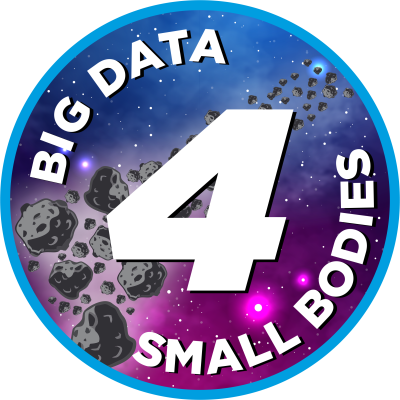Big Data for Small Bodies (BD4SB)
A research project developed at the Astronomical Institute of the Romanian Academy (AIRA). This project is financed by a grant of the Romanian National Authority for Scientific Research and Innovation, CNCS - UEFISCDI.
Project number PN-III-P1-1.1-TE-2019-1504.
Contract number: TE 173 registered on 23/10/2020
Duration: October 28, 2020 - October 27, 2022
Budget: 431.900,00 RON
Objectives
1) Understand the diversity of physical properties of asteroids with sizes in the meter to kilometer range by exploiting the observations provided by: a) the large surveys; b) existing asteroid spectral databases; c) and the spacecraft missions such as OSIRIS-REx and Hayabusa-2.
2) Envision a new picture of the processes the formed the small bodies: search for the possible early existence of differentiated and primitive bodies in the Main Belt, the possible heterogeneous origin of different classes of asteroids currently orbiting in the main belt, and the identification of remnants of early products of collisional evolution.
3) Consolidate our Romanian team of planetologists by participating in the top international research programs and by being active members in the working groups of the space-mission research teams and/ or all-sky surveys.
Key results
1) Widely distributed exogenic materials of varying compositions and morphologies on asteroid (101955) Bennu . Our result suggests that Bennu might record the remnants of multiple impacts with different compositions to its parent body, which could have happened in the very early history of the Solar system. Tatsumi & Popescu et al. 2021
2) Spectral properties of near-Earth objects with low-Jovian Tisserand invariant . We estimated the fraction of NEOs (near-Earth objects) with a cometary nature has the lower and upper bounds (1.5 ± 0.15) and (10.4 ± 2.2) per cent (for the absolute magnitudes in the interval 14 - 21). Simion et al. 2021
3) Visible color indices of near-Earth asteroids . We run a program to characterize near-Earth asteroids using the 1.52 m Telescopio Carlos Sánchez (TCS). More than 300 objects were characterized up to now (October 27, 2022). The preliminary results were presented during several conferences (e.g.Popescuet al. 2021 EPSC and an article will be submitted soon.
4) Participating in scientific working groups of various space missions Marcel Popescu is member of scientific team of NASA/DART and ESA/Hera (he is part of the core members for GROUND BASED OBSERVATIONS and DATA ANALYSIS, EXPLOTATION, INTERPRETATION). The article Tatsumi et al. 2021 has been published together with JAXA/Hayabusa2 space mission.
5) Consolidate our Romanian team of planetologists 1) Train new students: Gabriel Nicolae Simion, Jad Alexandru Mansour, George Pantelimon Prodan, Elena Alexandra Zaharia. 2) New telescope observations facility T025 - BD4SB. 3) Organizing observing campaigns of transneptunians occultations in Romania. This is a continues activity. The results of previous campaigns published as Santos et al. 2022, Vara-Lubiano et al. 2022, while the new observations are analyzed.
